
SRHS
Steamboat Rock Historical Society
SCHOOL CONSOLIDATION
THE BUSSING ISSUE
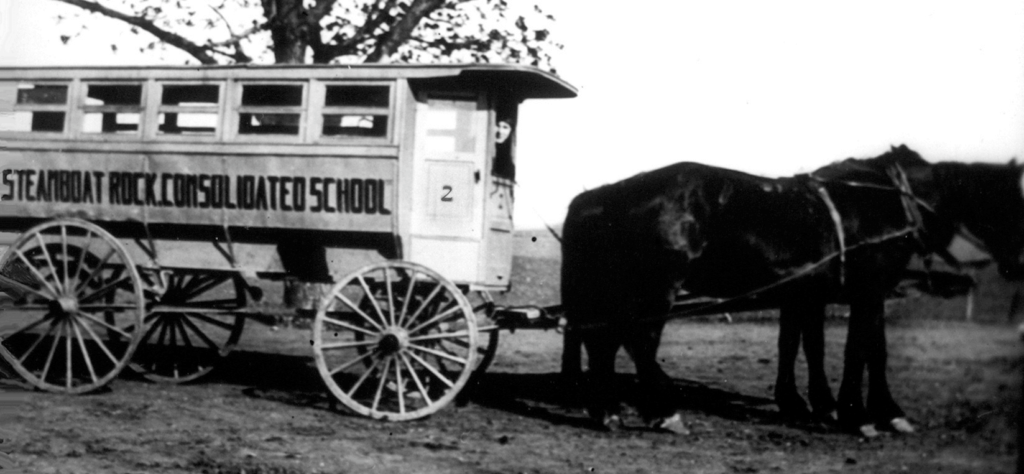
Marie Eilers drove one of Steamboat Rock Consolidated School’s first school busses. Some of the
families on her route included: Heye Folkerts children, and those of Alfred Gast, Leonard Taylor,
Carl DeVries, George Kramer, Emil Tietz, John Bolar, Castevens and Frerichs.
When all those little country schools began to close and the first steps were made to consolidate into one town school there came the problem of how to get the kids to and from school. When there was a school every 2 miles, everybody walked. But when it became 5,10, or more miles from school that was something else. The buses, like everything else, at first anyway ran on horsepower. These first buses were specially built rigs pulled by a pair horses.
In 1927, Henry Eilers, submitted the lowest bid for providing school bus service for a route that included half the west side of the Iowa River. The job of driving the bus went to his oldest daughter, Marie Eilers.
The bus itself was nothing but a wagon-box type of affair, mounted on a high-wheel running gear. It was windowless except at front and rear and the front with a slot through which the driver passed the lines. Benches ran the length of the bus so that the kids sat facing each other.
Marie set out each morning after hitching the horses to the bus, which was a special wagon designed for carrying a number of children. By 5:30 a.m. she was holding the reins of a pair of blind black horses pulling the gray wooden bus. Marie’s family lived where Jim Rose now lives, and her route began there with her three younger sisters as her first passengers. she proceeded northwest, and then made a circle back to town picking up the children.
In the winter much of the time it was dark both mornings and evenings on the bus route. There was a coal burning stove in the front of the bus close to the driver’s seat. The stove kept the bus warm, but what a sight for those seeing the bus go by with smoke rolling out of the chimney.
There was a lot of singing on the bus, to pass the time. Marie once recalled, “those were the good old days when you didn’t know about conveniences like riding in a car, and the hurry hurry to get somewhere.”
Although it took a great deal of time they always made it. If there was no school due to a blizzard, the telephone operator would give a general ring on the telephone to alert the parents.
Solid black side curtains were of course kept rolled down during the winter. In the spring, it was possible to roll up the side curtains on the bus. Only then could you forget about how cold the bus was in the winter and how long it took to get to school.
Each day, Marie had to reach the school by 8:30. The school day began at 9: 00. She then took the horses to a barn located where the baseball diamond is now. There she had to feed and water the horses. When she had completed this she headed to the post office where she worked for Mrs. Mary Morse, who was postmaster at the time.
Marie worked in the post office while the children were in school, and in the afternoon went back to the barn and hitched the horses and ran the route in reverse, returning the children to their homes.
Marie drove the old wooden school bus until 1935 when she became postmaster, and had to give up the job.
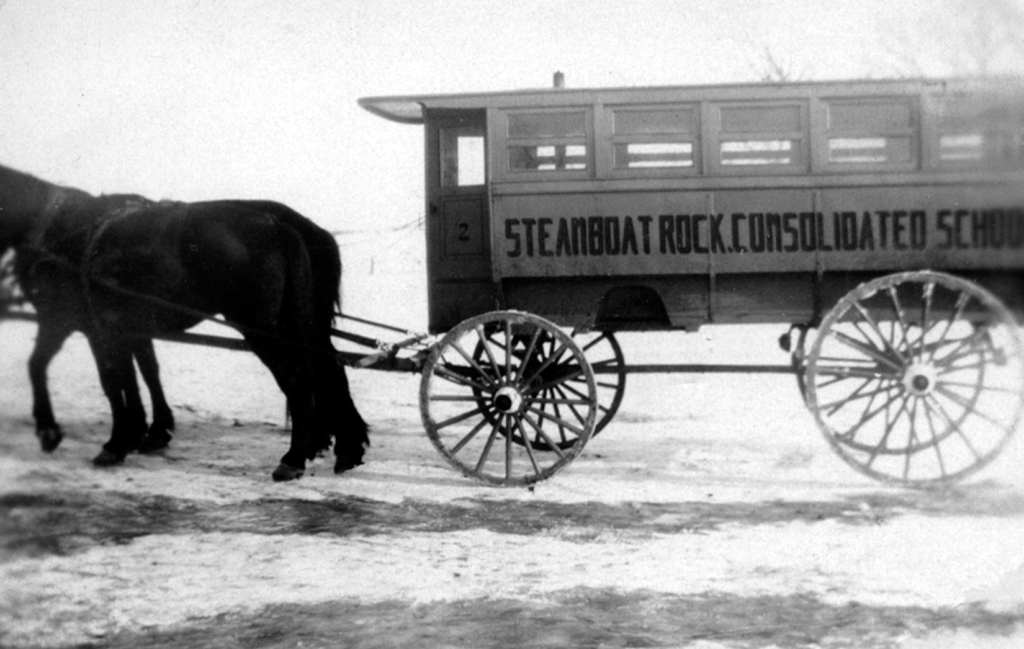
There were others who drove these routes. Swear Luiken and his brother Antone Luiken both drove horse drawn school bus routes on the east side of Steamboat.
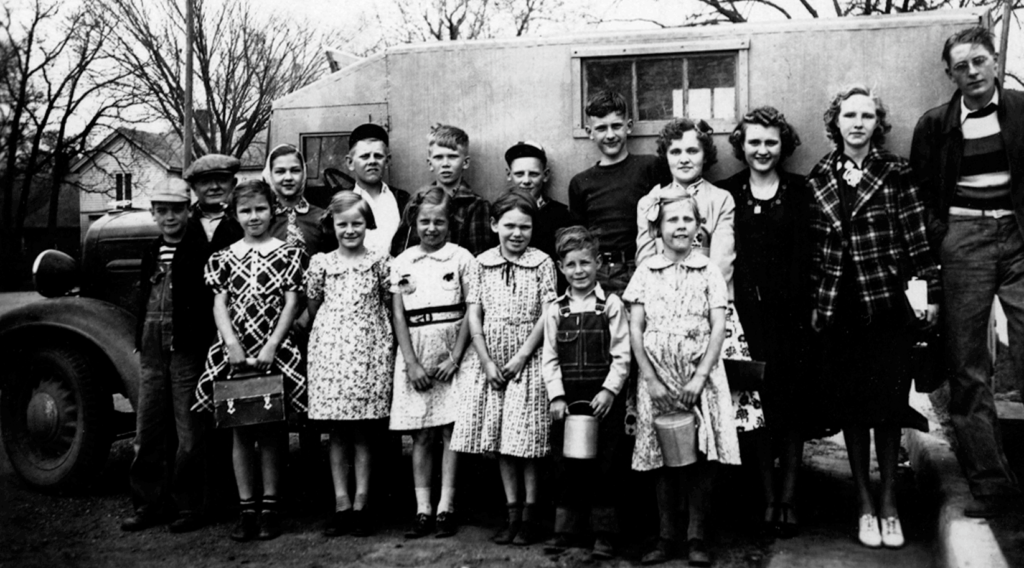
Dick Christians drove an early school bus that he made from a pickup. His route was northwest of Steamboat Rock. Swear and Antone Luiken who had driven the horse drawn buses later drove busses that were modified farm trucks. Bad roads were the biggest obstacle for the early school bus.
Esther (Folkerts) Daleske’s sister Anna (Folkerts) Akers taught in country school, and Esther drove an early school bus route of sorts.
In 1925, Esther’s father (George Folkerts) bought her a car (believed to be a 1924 Chevy Landau). Her sister Anna had just graduated from high school and was going to attend teachers college in Cedar Falls, Iowa. George bought Esther the car so she could drive Anna to Cedar Falls on Mondays and pick her up again on Fridays. Esther did this for the six weeks that it took Anna to get her degree.
Anna, was the first of George Folkerts’ children to graduate from high school, and the only one to attend college.
When Anna completed her education, she taught country school northeast of Steamboat Rock, called East School, or East Clay School. Many of the country schools had several names.
Each morning Esther would drive Anna to school and then use the car as a school bus to pick up children to take them to school in town on her way back. Harry and Luella Folkerts (a niece and nephew) were two of her riders.
Esther recalled that there were about five riders all together. In the afternoon after school, Esther would repeat the trip, returning the children to their homes and picking up Anna and taking her home. Esther was still a high school student at the time.
Esther drove her car as a bus, but at the same time other students were riding on less modern transportation.
Later there were trucks just plain farm trucks converted to school buses. Farmers would bid for a bus route and if they were successful would build an arrangement on their pickup, stock or grain truck. When converted they resembled something like a modern-day camper, at least in profile. Benches were tacked up along the walls and maybe one down through the middle. Any windows added were at the discretion of the builder.
Dick Christians, drove a pickup truck of sorts that he had modified to serve as school bus. Swear Luiken and his brother Antone drove modified truck/ busses.
It was well into the Thirties before anything resembling present-day school buses began to appear and when they did it seems they were ahead of their times in that the roads were not ready to handle them. It wasn’t just a matter of “snow days”; it was mud days in spring and fall when the bus couldn’t negotiate the average country roads. A major factor in getting gravel on country roads was to make it possible for the school busses to get through.
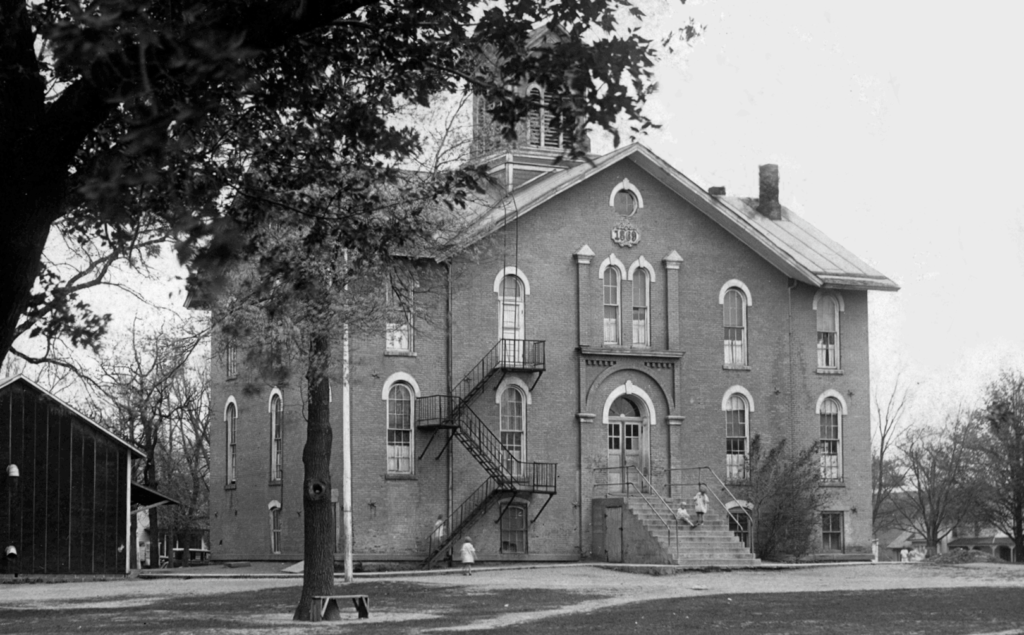
The old Steamboat school building had been modernized and remodeled during the period of consolidation and with the added attendance from the outlying rural areas, it was necessary to build a temporary annex building which accommodated two grades.It was not long before the makeshift facilities became very inadequate, and on February 24, 1928 a special meeting of the board of directors was held for the purpose of considering and passing a resolution providing for the issuance of $50,000 school building bonds for the purpose of erecting a new schoolhouse.
The members of the board at this time were: J. Willard Caldwell, President; H.H. Johnson, T.J. Eilers, Thomas Ruppelt, and L.A. Luiken, and J.A. Holmes was secretary. A.C. Halden was superintendent.
A special election was held on March 29, 1928 to vote on the new building issue which carried 193 for and 34 against with 7 spoiled ballots.
Construction of the new building was begun early that spring and the new one was completed and ready for occupancy late in the fall of the same year.
Lucille Doyle Pierson obtained her childhood education in the typical country schools and in 1928 she came to Steamboat Rock from the Eldora school as a freshman.
Lucille recalled, “It was such a sad day when I knew no one. Jurrena Frerichs Luiken, helped me get to classes. At noon we stood around a big heater in Johnson’s store.”
“In the spring of 1928 the school house was to be torn down. Classes were moved to different places in town. The summer was spent building the new structure. In the fall of “28” we walked to our new school house, one of the best in the state. Jurrena couldn’t come back to school and didn’t graduate with our class.”
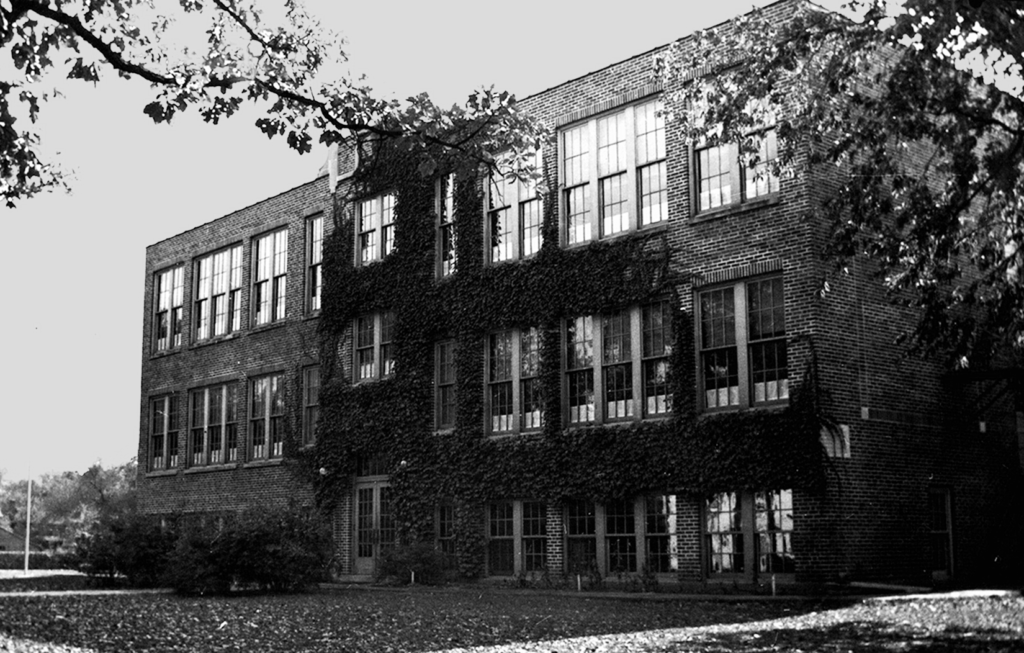
Lucille graduated with the class of 1931, and she then attended Ellsworth College in Iowa Falls and graduated in 1933.
Lucille sought a teaching position, and after Christmas in 1933, the teacher at the Cleves school was married. No married teachers could be hired back then, and the position became open. Through the efforts and a recommendation from Mr. E. B. Johnson, of Steamboat Rock, Lucille was given the position, and her long dedicated teaching career was begun at $40. per month. For $40 per month Lucille was also janitor, privy primper, responsible for discipline, and all 7th and 8th graders were expected to pass county exams.
Lucille, continued teaching in area country schools. She taught at the Leverton school for a year, and spent time with the Levertons, “where I had a warm room, good lunches and a short walk to school.”
“Bill Leverton went to the Eldora Library and brought home books, which were piled by his chair. I crocheted and played the piano. Bill said, ‘Why don’t you read and improve your mind?’”
“I was at the Wilts school a year. We did a community play. Abe Jaspers was a colored man and sang Old Black Jo. Ben Jaspers and Abe were good actors.”
© 2020 Steamboat Rock Historical Society | All Rights Reserved
Powered by Hawth Productions, LLC